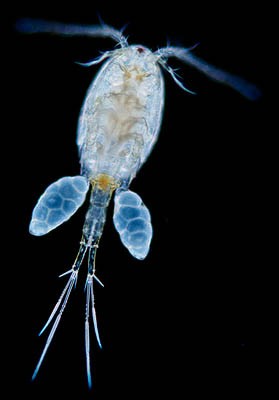The World’s Strongest Animal is the Copepod
 Today I found out the world’s strongest animal is the copepod.
Today I found out the world’s strongest animal is the copepod.
Relative to their size, typically about 1mm long, copepods are also the world’s fastest animal, being able to jump at a rate of about a half a meter per second. Their incredible strength, relative to their size, makes them over ten times stronger than any other known species on the planet and even stronger than any mechanical motor produced to date.
In order to achieve these great jumps, used to evade predators, the copepod uses two propulsion mechanisms and a very fast nervous system, which is very rare for invertebrates; they also have uniquely designed neural pathways with neurons surrounded by myelin, which increase the conduction speed. When they detect a predator, a signal is rapidly sent to their legs and set of antennae, which together causes them to jump with a ridiculous amount of force, relative to their size.
For perspective on just how much thrust power these little guys have, if you were able to jump with similar power behind your thrust or more aptly, scaled up the size vs distance/time unit traveled, you would be able to jump about half a mile in one second flat in water. In air, which has significantly less drag, you’d jump much further than that.
All this would of course depend greatly on the density of the water, drag, velocity, density of the base from which you were jumping from, etc., so it’s not simply a 1-1 correspondence that you can scale up like that. However, just for a fun ballpark estimate, assuming similar aerodynamics to the copepod, a relatively solid base to thrust from, and water density of around 1000kg/m^3 (typical salt water) vs air density of around 1.275 kg/m^3 (typical sea level), in air, you’d be jumping about 6-12 miles per second, if you had that kind of strength in proportion to your size that the copepod has.
If you liked this article and the Bonus Facts below, you might also enjoy:
- The Species of Jellyfish that Can Age Backwards
- How to Treat a Jellyfish Sting
- Lobsters Do Not Mate for Life
- How Shellfish Have Sex
Bonus Facts:
- All the copepods combined form the largest biomass on the Earth, followed close behind by the Antarctic krill.
- Copepods are a group of small crustaceans, of which there are about 13,000 varieties (half of which are parasitic), found in just about every place on the planet where moisture congregates, from the polar regions to moist moss to underwater streams and caves to public water systems. As such, they make great bio-indicators.
- It is estimated that copepods absorb 1-2 billion tons of carbon per year, which is about equivalent to 1/3 of all human carbon emissions and is significant enough to make them the largest carbon sink in the world.
- They also contribute to bringing carbon to the deep sea. Planktonic copepods, which absorb the carbon, feed near the surface at night and then sink into deep water in the day to avoid visual predators, bringing the carbon with them.
- Copepods are important food sources for many fish, whales, seabirds, crustaceans, and a variety of other sea-life.
- With these above things combined, copepods are one of the most important organisms on the planet, right up there with Earthworms.
- In some countries, such as Peru and Bangladesh, there has been a strong correlation found between copepods in drinking water and cholera, as the cholera bacteria attach to the surface of planktonic animals.
- The guinea worm also develops within the copepod’s digestive system and, if you drink water with copepods in it, will then find its way into you. Just so you know, filtering out copepods is as easy as running water through a cloth filter.
- Copepods often found in unfiltered drinking water has raised a major problem with orthodox Jews as copepods, being crustaceans, are not kosher and are too large to be ignored. Because of this, in places like New York, which does not filter its water, you’ll find most orthodox Jews will have installed water filters in their homes.
- Almost all varieties of copepod do not posses or need hearts or circulatory systems, due to their tiny size. They also almost all lack gills; rather, breath by absorbing oxygen directly into their bodies, also much like Earthworms.
- Many copepods store up energy in the form of oil droplets; this oil can grow to as much as half their body mass.
- Copepods can be used to control mosquito populations. The copepods can be added in significant numbers to the water where mosquitoes breed and will eat the mosquito larvae found there.
| Share the Knowledge! |
|





2 comments